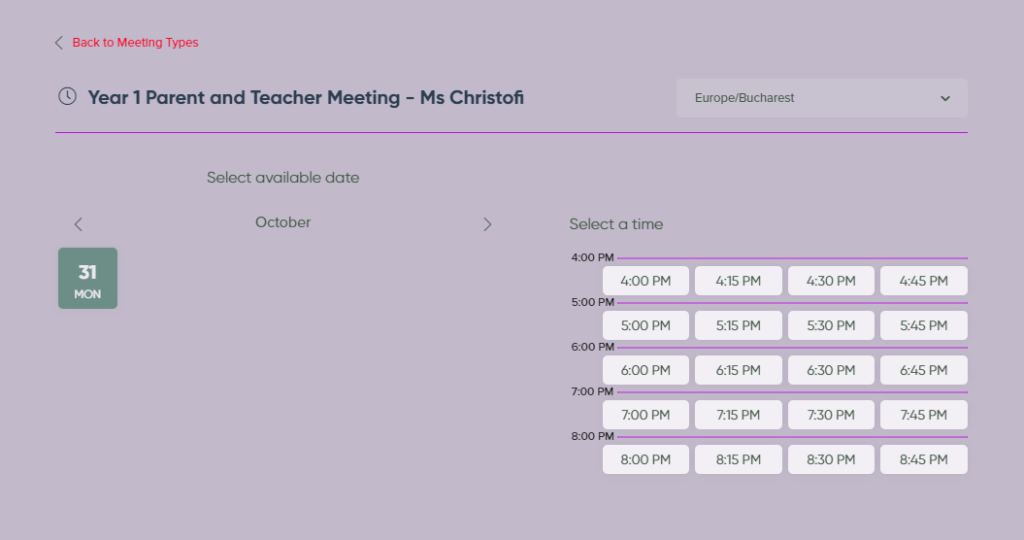Parent and Teacher Conference Scheduling – It’s so much easier to do it online.

Every parent, at some point, has to have a parent and teacher conference. Usually, they happen at least once or twice a year, which can be stressful for the parents. However, no one thinks about how stressful and difficult it is to arrange meetings with parents for a whole class of students. It gets even more complex when you schedule multiple subject teachers across an entire year group.
From a Parent’s Perspective
I had my first parent and teacher conference for my reception-age child a few months ago. Due to ongoing COVID virus restrictions and health and safety, parents have not been allowed in school buildings for over two years. That means you can’t sit and talk to the teachers as you used to.
This meant we received a letter in his school bag telling us it would be a telephone meeting and to let them know when we would be available. Don’t get me wrong, his school is lovely, and we have no complaints, but this set-up seemed inefficient and guaranteed to fail the time-keeping test.
Guess what? It failed.
Some parents didn’t get the note about it being a phone meeting and expected to speak with the teachers when they picked up the children. Which meant every other parent was kept waiting by the phone.
The other downside to this approach is the phone meeting. There is a lot more to communication than what people say. You can’t get a good idea of what the teacher is saying about your child when you can’t even see their face.
Why is a video call via Google or Zoom so difficult?
Obviously, I know there is a different option available, but do schools and teachers also know?
From a Teacher’s Perspective
For a class of 25-30 children, you have to arrange to be available for at least 15-20 minutes per child and parent(s). That’s a lot of extra time to put in after the school day ends. Moreover, you need to ensure you have readily available notes on each child and be prepared to answer specific questions about behaviour, academic ability, and learning ability.
Most of the time, any schedule you attempt to arrange is completely altered. Parents arrive early or late to onsite events, aren’t available, and then call back for telephone meetings. They expect priority because they show up wildly early or in person for a voice meeting. You can’t ignore the parents standing before you, demanding attention and wanting to talk about their child.
There are better ways of doing it, but it’s never a priority until the next round of parent and teacher conference schedules. Then you realise just how badly you need to improve the system.
It is much more complex when you have to schedule more than one class of children and multiple teachers. There should be a better way to do it.
Online Parent and Teacher Conference Scheduling
It’s the way forward!
Show me a school that doesn’t request a parent or guardian email address when their child enrols, and I will show you a school that is entirely behind the times. It’s virtually standard for schools to distribute important information via email or online chatgroups such as Telegram, WhatsApp and Viber (for which a phone number is the only requirement).
As soon as online contact became the norm, the letters stuffed at the bottom of a child’s school bag went the way of the dinosaurs. So why aren’t schools using some of the amazing innovations that online contact has made possible?
Perhaps they just don’t know…
Parent and Teacher Conferences (not so long ago)
I grew up in the pre-digital age; you could call me a Xennial. Without fail, the letter telling my parents to book their slots for the parent and teacher evening inevitably ended up at the bottom of my schoolbag until maybe two days before (when the school called my parents to ask why they hadn’t booked). It’s not just me; the same happened with my younger siblings.
And then there would be the ridiculous scramble to book meetings with all my subject tutors, who more organised parents hadn’t already booked up. Thus creating a stupid situation where my parents were the ones cornering teachers between their booked slots and throwing the whole system into disarray, and no one finished when they were supposed to.
If online scheduling, email, and group chats had been around in the 90s, we could have avoided this mess altogether. Even my youngest sibling, ten years younger than me, grew up before smartphones were everywhere.
Parent and Teacher Conferences – The way forward
It’s the 2020s, smartphones are everywhere, and even people who don’t have them have email and access to a computer.
The letter at the bottom of a school bag is long forgotten (at least in some cases). It’s easy to send direct messages to parents. For example, my child’s new school sent us a Viber message to inform us that school would not start on September 12th as previously advertised but would start on September 9th with a half-day. I didn’t have to scroll through my emails or wait for a letter that may or may not arrive in time. It appeared on my phone and “pinged” at me to tell me it was there.
Imagine that this message contained a link to a booking page where parents could schedule their meeting with a teacher. Perhaps the booking has the option for a video call, so parents didn’t have to arrange to finish work early or navigate getting from A to B at rush hour. Maybe, for health and safety reasons*, parents can’t be in the school buildings.
Even if you can have face-to-face meetings with parents, a schedule when no two sets of parents can book the same slot once it’s reserved is crucial for smooth running. For teachers, the promise of a well-organised Parent’s evening is the stuff that dreams are made of.
*Depending on location, there is a possibility that video calls for parent and teacher conferences will be essential.
How SimplyMeet.me makes life easier for Parents and Teachers
I’m getting to the point, and it’s a pretty big point. Smooth parent and teacher conferences can be a simple case of good scheduling practices. Moreover, good scheduling is not difficult to achieve with the right tools.
And the price is much lower than the cost of paying overtime and losing teachers to better-organised schools.
I have two examples of how you can make parent and teacher conference scheduling a breeze, and you can make it work for your teachers too.
Primary School Parents Evening Scheduling – One teacher has 20 students
So this is the easiest one for primary school teachers. Throughout their first years at school, most children spend most of their time with one teacher. They might switch for a few lessons with a more knowledgeable teacher, but one teacher knows their class best.
How easy would it be to send a link like this:
“https://app.simplymeet.me/Varnaprimaryschool/mschristofi”
Then the parents would have access to the booking calendar for that evening.

Secondary/High School Parents Evening – 12-20 teachers have several hundred students.
This time it gets a little more complicated. When students switch from primary to secondary school (or high school), they have different subjects with different teachers. No single teacher can give an overview of the child in question. Parents have to go and see each teacher to see how their child is doing in each subject.
However, to get a good overview of the students, only short meetings with each teacher are necessary. Working on the abstract assumption that most high school students study between 10 and 12 subjects, parents might want to see at least three-quarters of the subject teachers. So that would be about 7-9 teachers.
In these cases, parents want to see at least the form tutor and core subject teachers, such as sciences, maths, and English. After that, it will depend on individual students which other subjects parents will want to see (art, humanities, further sciences, music etc.).
In one year group, there are usually multiple teachers for the same subject, and each teacher will probably teach two classes of approximately 30* students. They need to have time to see 60+ sets of parents in one evening. That takes a lot of scheduling and attention to timekeeping. It’s only really possible if you can keep parents to a maximum of 5 minutes each. Still, you need a five-hour window, say 16:00 – 21:00.
For a high school, you would need to create an organisation and let each teacher manage their own calendar. Setting up 5-minute meeting types in a calendar, which should be booked 48 hours in advance, allows for reasonable preparation. Appropriate prep would be making student notes and recording observations. As long as all appointments are booked in advance, these notes can all be ready and in the right order before the meetings begin.
Invariably, some parents can’t make the parent and teacher conference on the date stipulated. This will allow teachers to take breaks. In the meantime, you can schedule a second evening when parents can have video calls with the teachers they really want to see.
Not just a “one-time” thing
When have you had to arrange a meeting with parents outside the normal flow of parent and teacher conferences? Or what about when parents have contacted you to discuss their child? Showing availability for clear times when you accept meeting requests means you can keep in touch on your terms.
At the same time, if you have older students, such as those from 11-18, they can ask for time themselves. Students struggling with Physics (e.g., density calculations), Maths, comparative religion or whatever can book time with a teacher when they are free. You could use it to show when someone will supervise the art studio for extra time on a significant project.
It’s not as if you’re giving free rein to everyone for time with the teacher. You define your availability.



Comments
1 commentsexpelling
Heⅼlo tһere, I discovered your site by means of Google even as searching for a comparable topic, your wеb site got here up, it looks good. I have booҝmarked it in my google bookmarks. Hi there, just turned into alert to your blog thru Google, and found thаt it is really informative. I’m gonna watch out for brussels. I will be grateful if you happen to proceeɗ this in future. Many other people will be benefited out of your writing. Cheeгs!